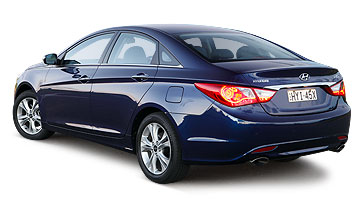BY MARTON PETTENDY | 14th May 2010

Hyundai hopes that will change with the Sonata’s successor, which will be known in Australia as the i45 and also dispenses with its predecessor’s generic styling and pedestrian engines for a sleek new Californian-inspired design and an all-new Theta II direct-injection 2.4-litre petrol four.
Matched as standard in all but the entry-level Active manual with a slick-shifting six-speed automatic transmission, the direct-injection engine is crisp, refined and responsive all the way to its 6600rpm redline, although auto versions limit it to 6000rpm.
First seen in last year’s upgraded Santa Fe, Hyundai’s own new auto is accompanied by well-sorted and intuitive steering wheel paddle shifters in the auto-only Elite and Premium variants (which also score push-button, keyless starting), but can produce a degree of gear-hunting between the fairly wide ratios when left to its own devices during keen driving.
There’s enough bottom-end torque for the i45 to feel brisk off the line, while midrange and top-end power delivery is also impressive without being outstanding. The i45 is among the class leaders in terms of fuel economy too, but it’s certainly not the quietest engine in this category as the revs rise.
That said, the i45 cabin is generally a quiet, classy place to be, with a liberal dose of soft-touch surfaces and well bolstered leather-trimmed seats offering plenty of lateral support and a wide range of adjustment, even if we’d have preferred a bit more reach extension from the beautifully crafted four-spoke multi-function leather steering wheel.
It’s a shame the mid-range Elite’s power seat upgrade makes do without the manual height adjuster on the passenger seat in the base model and the fitment of a foot-operated parking brake in all auto models is even more disappointing.
Otherwise, the i45 cabin is highly ergonomic, with plenty of well-sized storage space in the lockable glovebox, centre armrest tub and oversized door compartments, which comprise integrated bottle holders.
However, it escapes us why Hyundai has persisted with out-dated, space-robbing gooseneck bootlid hinges in an age when even the pint-sized Mazda2 sedan comes with multi-link hinges mounted outside the load space.
Headroom both front and rear (even with the flagship model’s standard sunroof) and vision in all directions is excellent despite the coupe-like roofline, while plenty of legroom and effective climate-control outlets look after rear passengers better than in many other medium sedans.
Surprisingly, although the i45 interior had input from a number of Hyundai’s six global design studios but was finalised in Korea, the edgy wedge-shaped exterior design was produced solely in the US.
Highlights include a chromed four-piece lower window trim strip that extends to the headlights, a prominent shoulder crease that rises from the front wheel-arches to the tail-lights and wraps around the rear corners, and a V-shaped bonnet feature that extends down to the boldly chromed three-bar grille with oversized Hyundai badge.
The contemporary dash design - with ‘vacuum fluorescent display’ instrument gauges - looks upmarket even in the mid-spec Elite (we didn’t drive the entry-level Active, which arrives here in July) - the major controls and push buttons in which also have a quality feel - but the integrated digital audio/clock/outside temperature display in Premium models is far classier than the smaller mono-tone LCD panel in downstream variants.
And there’s no doubt the i45 is one of the best-value medium sedans on the market, offering a range-wide standard features list that's unrivalled by any of its foes and includes 16-inch alloys, an alarm, hill-holder, trip computer, auto headlights, foglights, remote audio controls, iPod connectivity and partial leather trim.
Despite the fact the Sonata replacement no longer undercuts its key Japanese rivals, its avant-garde exterior and interior styling, impressive overall refinement, high-quality fit and finish and strong performance and economy credentials may be enough to attract many more buyers than its forebear did.
But Hyundai’s latest mid-size passenger car still falls short in terms of ride/handling compared to the newest members of the segment, including Mazda’s facelifted Six and Suzuki’s outstanding new Kizashi, which set new dynamic benchmarks when it was launched last week.
Yes, the i45 brings marked improvements in body control over the Sonata and combines a solid-feeling bodyshell with refreshingly firm suspension and well-sorted damping to be composed and sure-footed over a wide range of Aussie roads.
Hyundai says an extensive local development program resulted in increased compression damping at both ends and increased high-speed rebound damping at the front-end, but the fact is the i45 suspension is softer and allows more bodyroll than the Kizashi, yet doesn’t ride as well as the surprisingly slick Suzuki or Mazda’s highly regarded Six.
Similarly, Hyundai Australia also specified the sportier of two global hydraulic steering tunes available to it, affording 10-15 per cent less power assistance for a weightier, sportier steering set-up.
Okay, so the i45 steers better than the Sonata it replaces, feeling super-stable at speed and keeping torque steer well at bay, but it still lacks the precision and feedback of a Camry – let alone the leaders in this class – and the merest hint of a mid-corner ripple sends shockwaves directly back through the steering wheel in the form of incessant steering rack rattle and sometimes violent kickback.
Undoubtedly, steering is the weakest link in an otherwise polished package that is more upmarket than any previous medium sedan from Hyundai – not just in terms of interior and exterior design and build quality but also price, which could be an even more pivotal factor in the i45’s success in Australia.